Florida Trees and Shrubs
Page 7 of 11
Pineland acacia, Hog-plum, Florida swamp privet, Gray nicker, Florida rosemary, Shiny-leaved wild coffee, Velvet-leafed wild coffee, Natal plum, Papaya, White indigoberry
Pineland Acacia - Acacia farnesiana
Family - Fabaceae
Native
_small.jpg)
2_small.jpg)
Habitat - Dry pinelands, coastal areas
Description - Perennial shrub, small tree to 12 feet, spiny branches, green to grayish-green bipinnate leaf
Flower - Yellow pom-pom like flower about 3/4 inch in diameter. Fruit is a curved brown pod 1-3 inches, pointed at the tip.
Hog plum, Wild lime - Ximenia americana
Family - Olacaceae
Native

_small.jpg)
Habitat - Scrub, Hammocks, Dry Flatwoods.
Description - Native perennial shrub, sprawling growth habit almost vine like in nature. 3/4 inch spines at leaf axils. Semi-parasitic on roots of other trees although it does not harm them. Flower is small, white and inconspicuous, the fruit yellow and 3/4 to 1 inch in diameter.
Florida Privet, Florida Swamp Privet - Forestiera segregata
Family - Oleaceae
Native
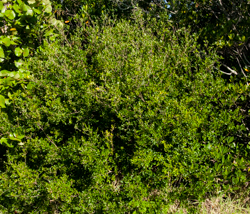
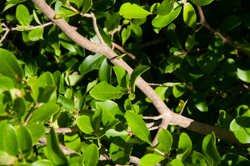
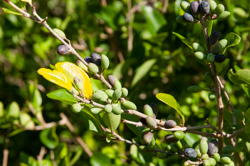
Krug%20&%20Urb)_small.jpg)
Small tree or large shrub, 5 -15 feet tall feet high with an more or less equal spread found growing mainly near the coast well behind the dune line on drier, sandy soils of coastal hammocks and scrub. Evergreen or briefly deciduous in the northern parts of the state. Leaves are opposite, with entire margins, elliptic to oblanceolate in shape and glabrous. Stems are light brown or gray, older branches with raised lenticels.
Small greenish-yellow flowers lacking a corolla are produced in singley or in clusters of three or four along the stems at the leaf axils, the fruit of the Florida privet is a 1/2 inch long olive shaped berry, purple or black colored upon ripening. The berries are an important food source for song birds and small mammals because it ripens early in spring before other fruits and berries.
Gray Nicker - Caesalpinia bonduc
Family - Fabaceae
Native


Habitat - Coastal strand, coastal hammocks
Description - Native perennial vine or shrub with spiny stems to 2 inches in diameter and 15 feet or more in length. Compound, shiny green bipinnate leaf with each leaflet up to 2 1/2 inches long.
Flower - Yellow, 1 inch, 5 petal flowers produced in clusters. Fruit is a 4 inch, flattened spiny pod, brown when mature which splits to reveal 2-3 round, hard, 1 inch diameter seeds.
White indigoberry - Randia aculeata
Family - Rubiaceae
Native
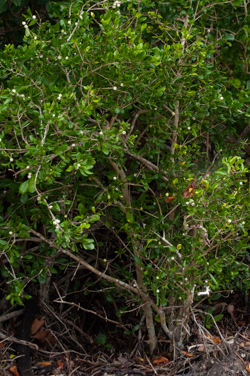
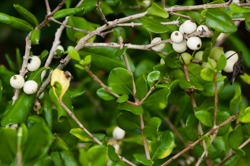
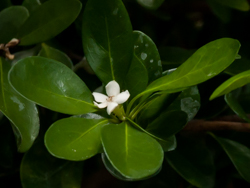
Evergreen shrub common to Florida's coastal hammocks, white indigoberry gets its common name from the dark blue pulp of the mature white berries that has been used as a dye.
This medium to large shrub averages 6-10 feet tall and is taller than wide. White indigoberry grows in full sun and partial shade on well drained, calcareous and sandy soils.
Leaves are shiny green, orbicular and 1/2 to 2 inches long, oppositely arranged and are generally clustered near the branch tips, the trunk and branches may have spines. Flowering occurs year-round, the white, 5 petaled flowers are a source of nectar for butterflies, berries are 1/2 - 1 inch in diameter and are eaten by birds.
Florida Rosemary - Ceratiola ericoides
Family - Empetraceae
Native
%20copy_small.jpg)
Habitat - Sandhill, sand pine scrub, oak scrub
Description - Perennial, subshrub, shrub, up to 6 feet in height with many stiffly erect stems. Leaf 1/2 inch, needle-like, opposite to whorled. Older individuals often have larger branches laying on the ground
Flower - Tiny, bronze to yellowish-brown, produced in clusters at leaf axils.
Shiny-leaved Wild Coffee - Psychotria nervosa
Family - Rubiaceae
Native

Habitat - Common in moist areas of coastal, oak and hardwood hammocks. Endemic to Florida within the continental U.S.
Description - Native shrub, 4 - 10 feet in height with elliptical to narrowly obovate dark green shiny leaves, 4 - 6 inches long with veins impressed into upper surface.
Small white flower in clusters produced at leaf axils, fruit is 3/8 inch red or yellow berry that closely resembles the true coffee bean.
Velvet-leafed wild coffee - Psychotria sulzneri
Family - Rubiaceae
Native
_small.jpg)

Habitat - Wet to moist hammocks, flatwoods
Description - Native Florida shrub to 8 feet tall, stems green to reddish-brown, leaves are opposite, 4-7 inches long, oblanceolate with entire margins and blue-green color. Clusters of small white flowers, fruit is a small red berry (drupe) 1/4 inch in diameter.
Natal Plum - Carissa macrocarpa
Family - Apocynaceae
Invasive / Exotic
_small.jpg)
_small.jpg)
Habitat - Escapes from cultivation, dry sandy soils
Description - Introduced shrub to 20 feet tall is widely cultivated, several hybrids produced. Dark green leaves are 2-3 inches long, opposite, ovate and have a glossy upper surface. Branches have 'Y' shaped spines to 3 inches long.
Flower - Fragrant 2 inch white flowers have 5 overlapped petals with a waxy look. Fruit is a red berry about 2 inches long.
Papaya - Carica papaya
Family - Caricaceae
Invasive / Exotic
_small.jpg)
Description - Introduced. Erect, unbranched soft trunk 6-20 feet (average 10') with umbrella like canopy of deeply palmate 7 lobed leaves borne on 24 inch long petioles. Bark is green to light brown.
Flower- Yellow, trumpet shaped, 2 inches. Fruit 3 1/2 inch, round to pear shaped.
Habitat - Hammocks, shell mounds, primarily near the coast.
Inkberry, Gallberry - Ilex glabra
Family - Aquifoliaceae
Native

%20flower_small1.jpg)
Habitat - Moist to wet flatwoods, sand scrub, hammocks, bogs and swamps
Description - Native perennial shrub, 4 - 6 feet tall, the obovate to elliptic, leathery leaves are 1 1/2 to 3 1/2 inches long, simple, alternately arranged with smooth or finely toothed margin.
Flower is greenish white, single at leaf axils followed by round 1/4 inch shiny black fruits that persist through winter.
Inkberry leaves are browsed by Marsh rabbits and White tailed-deer, the fruits are an important food source for Raccoon, Coyote, Opossum and many birds, including Quail and Wild turkey, especially in winter when other food sources are scarce